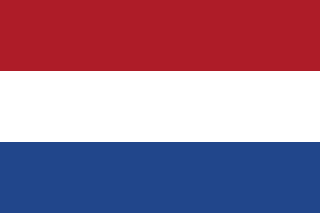
The Dutch government-in-exile, also known as the London Cabinet, was the government in exile of the Netherlands, supervised by Queen Wilhelmina, that fled to London after the German invasion of the country during World War II on 10 May 1940. The government had control over the Free Dutch Forces.

Beringen is a city and municipality located in the Belgian province of Limburg. The Beringen municipality includes the town of Beringen proper and the old communes of Beverlo, Koersel, and Paal.
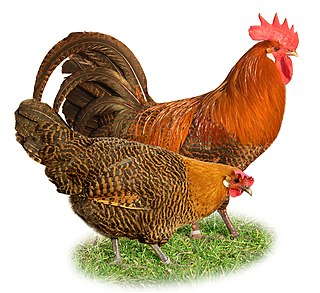
The Braekel or Brakel is a traditional Belgian breed of chicken. It is thought to have originated in the area of Brakel, in the Flemish province of East Flanders, for which it is named. There is a bantam version of the Braekel. The Campine of the United Kingdom derives from it.

Trouw is a Dutch daily newspaper appearing in compact size. It was founded in 1943 as an orthodox Protestant underground newspaper during World War II. Since 2009, it has been owned by DPG Media. Trouw received the European Newspaper Award in 2012. Cees van der Laan is the current editor-in-chief.

Jannetje Johanna (Jo) Schaft was a Dutch resistance fighter during World War II. She became known as "the girl with the red hair". Her secret name in the resistance movement was "Hannie".

The Campine or Kempen is a natural region situated chiefly in north-eastern Belgium and parts of the south-eastern Netherlands which once consisted mainly of extensive moors, tracts of sandy heath, and wetlands. It encompasses a large northern and eastern portion of Antwerp Province and adjacent parts of Limburg in Belgium, as well as portions of the Dutch province of North Brabant and Dutch Limburg around Weert.

The Dutch resistance to the German occupation of the Netherlands during World War II can be mainly characterized as non-violent. The primary organizers were the Communist Party, churches, and independent groups. Over 300,000 people were hidden from German authorities in the autumn of 1944 by 60,000 to 200,000 illegal landlords and caretakers. These activities were tolerated knowingly by some one million people, including a few individuals among German occupiers and military.

Renesse is a village in the Dutch province of Zeeland. It is a part of the municipality of Schouwen-Duiveland, and lies about 28 km west of Hellevoetsluis.

Postel Abbey is a Premonstratensian abbey in the Belgian municipality of Mol in the province of Antwerp.
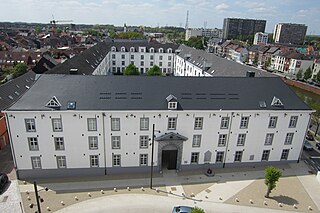
The Mechelen transit camp, officially SS-Sammellager Mecheln in German, also known as the Dossin barracks, was a detention and deportation camp established in a former army barracks at Mechelen in German-occupied Belgium. It served as a point to gather Belgian Jews and Romani ahead of their deportation to concentration and extermination camps in Eastern Europe during the Holocaust.

Jozef Simons was a Flemish writer and poet. Jozef Simons was active in the socio-cultural life of the Campine, among other things as a President of the Association of Campine writers (1937–1948). Together with Felix Timmermans, Ernest Claes and the poet Jozef De Voght he was one the writers of the Belgian Campine during the interbellum.
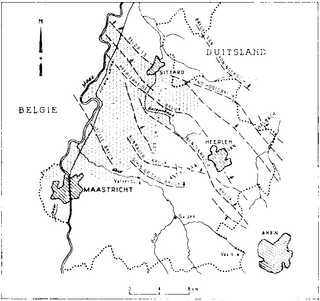
The Houthem Formation, named after the Dutch town of Houthem, is a geological formation that crops out in the south of Belgian and Dutch Limburg. It has also been found in borings in the northeastern part of the Campine Basin. The formation consists of calcareous sandstone and was formed about 60 million years ago, in the Paleocene epoch.
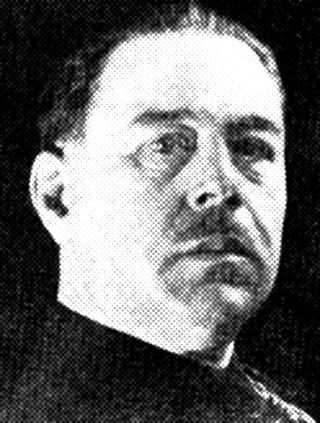
Paul Hoornaert was a Belgian far right political activist. Although a pioneer of fascism in the country he was an opponent of German Nazism and, after joining the Belgian Resistance during the German occupation, died in Nazi custody.

The Secret Army was an organisation within the Belgian Resistance, active during the German occupation of Belgium during World War II. With more than 54,000 members, it was by far the largest resistance group active in the country.

The Weerbaarheidsafdeling was the paramilitary arm of the National Socialist Movement in the Netherlands (NSB), the fascist political party that collaborated with the German occupiers of the Netherlands during World War II. The organization, roughly equivalent to the German SA, was founded in 1932 by Anton Mussert, co-founder of the NSB in 1931 and its leader until the end of the war. Members wore and marched in black uniforms and were thus called "blackshirts". In 1933 the Dutch government banned the wearing of uniforms, and the WA was disbanded in 1935 in order to forestall the Dutch government's banning it. In 1940, after the German invasion, the WA became openly active again, and more ruthless than before. They specialized in violent attacks, particularly on the Dutch Jewish population.

Various kinds of clandestine media emerged under German occupation during World War II. By 1942, Nazi Germany occupied much of continental Europe. The widespread German occupation saw the fall of public media systems in France, Belgium, Poland, Norway, Czechoslovakia, Northern Greece, and the Netherlands. All press systems were put under the ultimate control of Joseph Goebbels, the German Minister of Propaganda.
Augustus Franciscus Joseph De Boodt was from 1936 to 1968, senator District Mechelen – Turnhout. He was a member of the CVP. He was Councilor Turnhout from 1936 to 1946. In 1950, he was appointed Minister of Reconstruction by Joseph Pholien.

Wim van Norden was a Dutch journalist. He was one of the founders of the resistance paper Het Parool during World War II. He was jailed for six months by the Germans in 1942 but was later released due to lack of evidence for his involvement with Het Parool. Van Norden was active in the resistance for the remainder of the war. After the war he became director of the newspaper and although he originally planned to serve for only several months he kept his function until 1979. Van Norden was responsible for the founding of the publishing company Perscombinatie in which three newspapers worked together.

Thibo Roger Baeten is a Belgian professional footballer who plays as a forward for Dutch Eerste Divisie club Roda JC on loan from Go Ahead Eagles.

The 2022–23 season marked the 115th season in Feyenoord's history and the club's 101st consecutive season in the top flight of Dutch football. In addition to competing in the domestic league, Feyenoord also participated in this season's editions of the KNVB Cup and the UEFA Europa League.



















